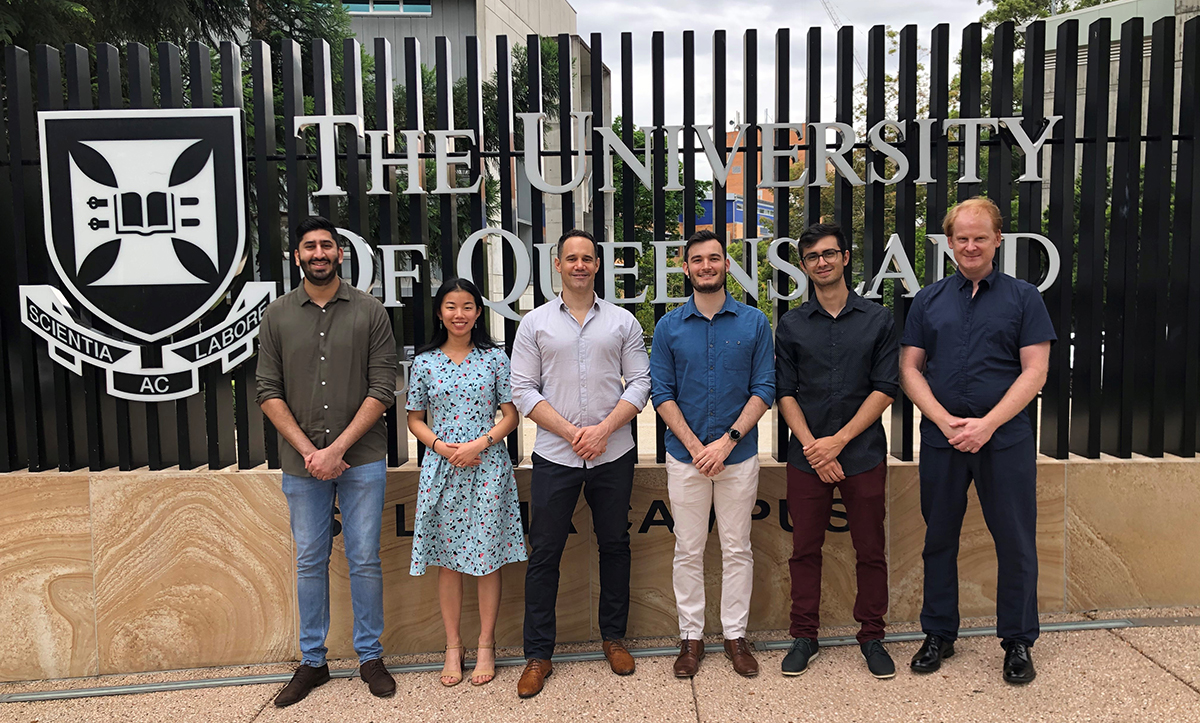
The main interest of the lab is Excitation-Contraction Coupling and Calcium Regulation in Skeletal Muscle. The focus is to understand the mechanisms that (i) control calcium release during activity in muscle, and (ii) maintain calcium homeostasis in skeletal muscle fibres. Within this broad focus, the roles of ion channels, pumps and membrane lipid composition in skeletal muscle physiology are studied. Significant emphasis is given to how properties of the muscle change in disease and other stressed states. To unravel the physiological mechanisms that control skeletal muscle activity, imaging of muscle cell structures and calcium movements are performed.
We have recently started working human muscle fibres obtained from needle biopsies, in conjunction with our colleagues in The School of Human Movement. We hope to gain a greater understand of ionic regulation in human muscle health, exercise and disease states.
- 2024-2027: Australian Research Council Discovery Project, $562,000, Heat regulation by the fibre types in muscle.
- 2024-2025: Jain Foundation, $300,000, Cholesterol and dysferlinopathy.
- 2022-2025: Australian Research Council Discovery Project, $608,000, Regulated muscle-based thermogenesis for body temperature regulation.
- 2020-2023: Australian Research Council Discovery Project, A$508,000: Sarcoplasmic reticulum-mitochondrial functional interactions in muscle.
- 2020-2022: RYR1 Foundation, Research Grant, US$100,000: Assessment of the ability of small molecule RyR modulators to correct the Ca2+ fluxes in skeletal muscle fibers with RyR myopathy.
- 2020-2022: Perry M, Gilles R, Bjorksten A, Launikonis BS, Diagnosing Malignant Hyperthermia from Muscle Fibres obtained from Needle Biopsy, Australia and New Zealand College of Anesthetists, AUD$60,000
- 2019-2021: AFM-Telethon, Research Grant, A$122,000: Junctional membrane calcium dynamics in skeletal muscle fibres with ryanodine receptor variants.
- 2019-2020: Jain Foundation, Research Grant, A$202,000: Ca2+ handling and tubular (t-) system function in dysferlinopathy.
- 2018-2021: Australian Research Council Discovery Project, A$530,000: Calcium cycling and heat generation in skeletal muscle fibres.
Launikonis BS, Murphy RM. Annu Rev Physiol. (2025). From Muscle-Based Nonshivering Thermogenesis to Malignant Hyperthermia in Mammals. Annual Review Physiology doi: 10.1146/annurev-physiol-022724-105205.
Gaglianone RB, Launikonis BS (2024). Muscle fibre mitochondrial [Ca2+ ] dynamics during Ca2+ waves in RYR1 gain-of-function mouse. Acta Physiol (Oxf). 240(3):e14098.
Singh DP, Pearce L, Choi RH, Meizoso-Huesca A, Wette SG, Scott JW, Lamboley CR, Murphy RM, Launikonis BS (2023). Evolutionary isolation of ryanodine receptor isoform 1 for muscle-based thermogenesis in mammals. Proc Natl Acad Sci U S A.120(4):e2117503120.
Meizoso-Huesca A, Pearce L, Barclay CJ, Launikonis BS (2022). Ca2+ leak through ryanodine receptor 1 regulates thermogenesis in resting skeletal muscle. Proc Natl Acad Sci U S A. 119(4):e2119203119.
Seng C, Pearce L, Meizoso-Huesca A, Singh DP, Murphy RM, Lamboley CR, Launikonis BS (2022). Tiny changes in cytoplasmic [Ca2+] cause large changes in mitochondrial Ca2+: what are the triggers and functional implications? Am J Physiol Cell Physiol. 323(4):C1285-C1289.
Barclay CJ, Launikonis BS (2022). A mathematical model to quantify RYR Ca2+ leak and associated heat production in resting human skeletal muscle fibers. J Gen Physiol. 154(9):e202112994. doi: 10.1085/jgp.202112994.
Pearce L, Meizoso-Huesca A, Seng C, Lamboley CR, Singh DP, Launikonis BS (2022). Ryanodine receptor activity and store-operated Ca2+ entry: Critical regulators of Ca2+ content and function in skeletal muscle. J Physiol. doi: 10.1113/JP279512.
Lamboley CR, Pearce L, Seng C, Meizoso-Huesca A, Singh DP, Frankish BP, Kaura V, Lo HP, Ferguson C, Allen PD, Hopkins PM, Parton RG, Murphy RM, van der Poel C, Barclay CJ, Launikonis BS (2021). Ryanodine receptor leak triggers fibre Ca2+ redistribution to preserve force and elevate basal metabolism in skeletal muscle. Science Advances 7, eabi7166.
Meizoso-Huesca A, Launikonis BS (2021). The Orai1 inhibitor BTP2 has multiple effects on Ca2+ handling in skeletal muscle. J Gen Physiol 153, e202012747.
Rebbeck RT, Singh DP, Janicek KA, Bers DM, Thomas DD, Launikonis BS & Cornea RL(2020). RyR1-targeted drug discovery pipeline integrating FRET-based high-throughput screening and human myofiber dynamic Ca2+ assays. Sci Rep 10(1):1791.
Barclay CJ & Launikonis BS (2019). Components of heat activation in skeletal muscle. J Muscle Res Cell Mot doi: 10.1007/s10974-019-09547-5.
Koenig X, Choi RH, Schicker K, Singh DP, Hilber K & Launikonis BS (2019). Mechanistic insights into store-operated Ca2+ entry during excitation-contraction coupling in skeletal muscle. BBA - Molecular Cell Research 1866, 1239-1248. (Special Issue: European Calcium Society Meeting).
Cully TR, Choi RH, Bjorksten AR, Stephenson DG, Murphy RM & Launikonis BS (2018). Junctional membrane Ca2+-dynamics in human muscle fibers are altered by malignant hyperthermia causative RyR mutation. Proc Natl Acad Sci USA. 115, 8215-8220.
Koenig X, Choi RH & Launikonis BS (2018). Store-operated Ca2+ entry is activated by every action potential in skeletal muscle. Communications Biology 1, 31.
Launikonis BS, Cully TR, Csernoch L & Stephenson DG (2018). NHE- and diffusion-dependent proton fluxes across the tubular system membranes of fast-twitch muscle fibers of the rat. J Gen Physiol 150, 95-110.
Choi RH, Koenig X & Launikonis BS (2017). Dantrolene requires Mg2+ to arrest malignant hyperthermia. Proc Natl Acad Sci USA 114, 4811-4815.
Bakker AJ, Cully TR, Wingate C, Barclay CJ & Launikonis BS (2017). Doublet stimulation increases Ca2+ binding to troponin C to ensure rapid force development in skeletal muscle. J Gen Physiol 149, 323-334.
Cully, Tanya R., Edwards, Joshua N., Murphy, Robyn M. and Launikonis, Bradley S. (2016) A quantitative description of tubular system Ca2+ handling in fast- and slow-twitch muscle fibres. Journal of Physiology, 594 11: 2795-2810. doi:10.1113/JP271658
Cully, Tanya R. and Launikonis, Bradley S. (2016) Leaky ryanodine receptors delay the activation of store overload-induced Ca2+ release, a mechanism underlying malignant hyperthermia-like events in dystrophic muscle. American Journal of Physiology: Cell Physiology, 310 8: C673-C680. doi:10.1152/ajpcell.00366.2015
Cully, Tanya R., Edwards, Joshua N. and Launikonis, Bradley S. (2014) Activation and propagation of Ca2+ release from inside the sarcoplasmic reticulum network of mammalian skeletal muscle. Journal of Physiology, 592 17: 3727-3746. doi:10.1113/jphysiol.2014.274274
Jayasinghe, Isuru D., Munro, Michelle, Baddeley, David, Launikonis, Bradley S. and Soeller, Christian (2014) Observation of the molecular organization of calcium release sites in fast- and slowtwitch skeletal muscle with nanoscale imaging. Journal of the Royal Society Interface, 11 99: . doi:10.1098/rsif.2014.0570
Jayasinghe, Isuru D. and Launikonis, Bradley S. (2013) Three-dimensional reconstruction and analysis of the tubular system of vertebrate skeletal muscle. Journal of Cell Science, 126 17: 4048-4058. doi:10.1242/jcs.131565
Jayasinghe, Isuru D., Lo, Harriet P., Morgan, Garry P., Baddeley, David, Parton, Robert G., Soeller, Christian and Launikonis, Bradley S. (2013) Examination of the subsarcolemmal tubular system of mammalian skeletal muscle fibers. Biophysical Journal, 104 11: L19-L21. doi:10.1016/j.bpj.2013.04.029
Cully, Tanya R. and Launikonis, Bradley S. (2013) Store-operated Ca2+ entry is not required for store refilling in skeletal muscle. Clinical and Experimental Pharmacology and Physiology, 40 5: 338-344. doi:10.1111/1440-1681.12078
Cully, Tanya R., Edwards, Joshua N., Friedrich, Oliver, Stephenson, D. George, Murphy, Robyn M. and Launikonis, Bradley S. (2012) Changes in plasma membrane Ca-ATPase and stromal interacting molecule 1 expression levels for Ca2+ signaling in dystrophic mdx mouse muscle.. American Journal of Physiology - Cell Physiology, 303 5: C567-C576. doi:10.1152/ajpcell.00144.2012
Edwards, Joshua N., Cully, Tanya R., Shannon, Thomas R., Stephenson, D. George and Launikonis, Bradley S. (2012) Longitudinal and transversal propagation of excitation along the tubular system of rat fast-twitch muscle fibres studied by high speed confocal microscopy. Journal of Physiology, 590 3: 475-491. doi:10.1113/jphysiol.2011.221796
Edwards, Joshua N., Blackmore, Daniel G., Gilbert, Daniel F., Murphy, Robyn M. and Launikonis, Bradley S. (2011) Store-operated calcium entry remains fully functional in aged mouse skeletal muscle despite a decline in STIM1 protein expression. Aging Cell, 10 4: 675-685. doi:10.1111/j.1474-9726.2011.00706.x
Launikonis, Bradley S., Murphy, Robyn M. and Edwards, Joshua N. (2010) Toward the roles of store-operated Ca(2+) entry in skeletal muscle. Pflugers Archiv - European Journal of Physiology, 460 5: 813-823. doi:10.1007/s00424-010-0856-7
Edwards, Joshua N., Friedrich, Oliver, Cully, Tanya R., von Wegner, Frederic, Murphy, Robyn M. and Launikonis, Bradley S. (2010) Upregulation of store-operated Ca2+ entry in dystrophic mdx mouse muscle. American Journal of Physiology: Cell Physiology, 299 1: C42-C50. doi:10.1152/ajpcell.00524.2009
Edwards, Joshua N., Murphy, Robyn M., Cully, Tanya R., von Wegner, Frederic, Friedrich, Oliver and Launikonis, Bradley S. (2010) Ultra-rapid activation and deactivation of store-operated Ca2+ entry in skeletal muscle. Cell Calcium, 47 5: 458-467. doi:10.1016/j.ceca.2010.04.001
Launikonis, Bradley S., Stephenson, D. George and Friedrich, Oliver (2009) Rapid Ca2+ flux through the transverse tubular membrane, activated by individual action potentials in mammalian skeletal muscle. Journal of Physiology, 587 10: 2299-2312. doi:10.1113/jphysiol.2009.168682
Edwards, Joshua N. and Launikonis, Bradley S. (2008) The accessibility and interconnectivity of the tubular system network in toad skeletal muscle. The Jounal of Physiology, 586 21: 5077-5089. doi:10.1113/jphysiol.2008.155127
Launikonis, BS and Rios, E (2007) Store-operated Ca2+ entry during intracellular Ca2+ release in mammalian skeletal muscle. Journal of Physiology-london, 583 1: 81-97. doi:10.1113/jphysiol.2007.135046
Launikonis, B. S., Zhou, J. S., Royer, L., Shannon, T. R., Brum, G. and Rios, E. (2006) Depletion "skraps" and dynamic buffering inside the cellular calcium store. Proceedings of The National Academy of Sciences of The United States of America, 103 8: 2982-2987. doi:10.1073/pnas.0511252103
Effects of inflammation due to COVID-19 infection on cardiac and skeletal muscle
COVID-19 infection induces inflammation that affects the normal function of cardiac and skeletal muscle. To be able to test pharmacological agents against the effects of inflammation it is important that we explore the mechanisms of decline in cardiac and skeletal muscle function under COVID-19 infection.
Effects of exercise on Ca2+ handling and metabolism in human skeletal muscle
Following exercise or training, the adaptations such as increased endurance rely on the change in mitochondrial capacity. The biogenesis of mitochondria is likely triggered by changes in the way Ca2+ is distributed in the post-exercised muscle. This project will use the latest techniques to explore the effects of exercise on human muscle fibres obtained from fresh biopsies.
The evolution of thermogenesis in skeletal muscle
Amphibians and mammals use the same proteins and ultrastrual arrangement of the muscle fibre for contration. However, mammals have evolve to use their muscle for the additional purpose of generating heat to maintain body temperature. It is not clear how this has been possible. This project will employ measure of heat and Ca2+ movements in toads, mice and human muscle to explore the evolution of muscle-based thermogenesis.
- Prof Robyn Murphy, La Trobe University, Melbourne, Australia
- Associate Prof Razvan Cornea, University of Minnesota, USA.
- Prof Christian Soeller, University of Exeter, UK
- Dr Izzy Jayasinghe, University of Sheffield, UK
- Dr Xaver Koenig, Medical University of Vienna, Austria
- Dr Jeff Erickson, University of Otago, New Zealand
If you would like to make a tax deductible donation to muscle research, please contact med.advancement@uq.edu.au. Thank you for your support.
Find out more about our diverse range of research interests.




